You’re running campaigns across multiple channels, but can you say with confidence what’s actually driving results?
Most brands can’t. Between messy reports, shallow attribution, and KPIs that don’t tie back to revenue, it’s easy to waste budget without even realizing it.
That is why building a clear, focused measurement strategy matters more than ever.
When you track the right metrics, apply the right methods, and use the right tools, you stop reacting blindly and start making decisions that move your brand forward.
In this blog, we’ll cover:
- Channel-based metrics that actually matter
- Core measurement methods (attribution, lift, MMM)
- Tools to track performance clearly
- Tips for choosing the right approach
- Common pitfalls to avoid
P.S. Struggling to tie your ad spend to real business outcomes? inBeat helps you run smarter campaigns, with clear KPIs, tighter targeting, and data-backed creative that performs. Book a free strategy call now!
TL;DR:
Why it matters: Most teams collect data but fail to connect it to outcomes. A focused measurement strategy helps tie marketing activity to business growth.
What to track by channel:
- Lead Generation: Cost per lead, lead conversion rate, MQLs
- SEO and Website: Organic traffic, ranking keywords, bounce rate, domain authority
- Paid Ads: Click-through rate, cost per acquisition, return on ad spend
- Social and Content: Engagement rate, follower growth, post saves and shares
- Email: Open rate, email CTR, unsubscribe rate
Strategic vs. Tactical KPIs:
- Strategic KPIs: Long-term impact (ROI, CLTV, MRR)
- Tactical KPIs: Real-time performance (CPC, bounce rate, CTR)
Match your KPIs to business model and funnel stage.
Key methods for accurate measurement
- Attribution modeling shows which touchpoints drive conversions
- A/B testing compares versions to optimize campaigns
- Marketing mix modeling evaluates online and offline impact together
- Conversion-lift studies isolate real campaign impact
- Funnel analysis identifies friction across the customer journey
Tool recommendations
- Google Analytics 4: Tracks user actions and conversion paths
- HubSpot: Combines CRM with marketing analytics
- Tableau: Visualizes data from multiple sources
- Mixpanel: Focuses on product and behavioral insights
- Ruler Analytics: Connects marketing to revenue using multi-touch attribution
Common challenges
- Siloed data across tools
- Confusion around attribution
- Gaps in offline conversion tracking
- Overwhelming amount of metrics
- Limited visibility due to privacy and tracking restrictions
Tips based on budget
- Under 3M: Use built-in tracking tools like GA4 and Meta Ads Manager
- 3M-5M: Add A/B testing and lift studies
- Over 5M: Layer in marketing mix modeling for long-term ROI insight
Key takeaways
- Choose KPIs based on your goals and funnel stage
- Use multiple measurement methods for a fuller picture
- Match tools to your team’s size, budget, and goals
- Measurement enables smarter campaigns and better decision-making
Need help connecting performance to growth? inBeat Agency offers strategy, targeting, and creative built on data. Book a free call to get started.
What Is Marketing Measurement?
Marketing measurement means tracking how your campaigns perform using real data. It connects marketing activity to business outcomes through key performance indicators like click-through rate, cost per lead, and return on investment.
Whether you’re running Google Ads, sharing social media posts, or managing a full digital marketing strategy, measurement shows what’s effective. It helps your teams move away from gut instincts toward decisions backed by marketing analytics, customer data, and clear performance indicators.
Why Marketing Measurement Matters Today
Marketing teams aren’t flying blind anymore. With so much performance data available, the pressure is on to prove what’s working. Yet 87% of marketers say data is still their company’s most under-used asset. This disconnect is costly, as companies using data-driven strategies see 5 to 8 times higher ROI than those that don’t.
That’s why marketing measurement has become mission-critical. It supports accountability, helps justify budgets, and gives senior marketers the tools to tie campaign performance directly to business outcomes.
The need for alignment is also growing fast. Teams today are working with 230% more marketing data than just a few years ago, but 56% say they don’t have time to analyze it properly.
Without a structured measurement strategy, most of that potential goes untapped. Tracking content metrics, Google Ads performance, search clicks, email stats, and social media interactions gives teams a clearer view of the entire customer journey.
Core Marketing KPIs to Track by Channel
Every team needs clarity on which metrics actually reflect performance. With so much data available, it’s easy to track too much or focus on the wrong ones.
Not all KPIs serve the same purpose. Some are tied to long-term business outcomes, while others measure day-to-day activity.
Strategic KPIs are lagging indicators like customer lifetime value, return on investment, and monthly recurring revenue. These help teams track progress against broader marketing and business strategy and business goals because they predict future outcomes.
On the other hand, tactical KPIs are leading indicators, focusing on evaluating past actions. These include click-through rates, cost per click, bounce rate, and form conversions. They give real-time insight into campaign performance and help marketers fine-tune what’s happening across channels.
If you want a deeper dive into leading vs lagging indicators, here’s a good starting point:
Examples by business type
The right performance indicators depend on your business model:
- SaaS companies usually focus on monthly recurring revenue, customer lifetime value, trial signups, and demo requests.
- Sales-led teams track pipeline value, opportunity stage progression, and lead quality.
- E-commerce brands prioritize average order value, return on ad spend, cart activity, and bounce rate.
Matching KPIs to your model helps ensure your marketing analytics support clear, strategic decisions.
Lead Generation KPIs
These KPIs help track how well your campaigns are turning interest into potential revenue.
- Cost Per Lead (CPL): How much it costs to bring in a new lead through your marketing efforts.
- Lead Conversion Rate: The percentage of leads who take action, such as submitting a form or starting a trial.
- Marketing Qualified Leads (MQLs): Leads that show buying intent based on engagement, fit, or scoring models.
Website & SEO KPIs
Together, these metrics reflect how well your SEO and website content support discovery and engagement.
- Organic Traffic: The number of visitors coming from unpaid search engine results.
- Number of Organic Keywords: The number of essential target keywords that your website ranks for.
- Bounce Rate: How often users land on a page and leave without interacting.
- Domain Authority: A measure of your site’s credibility and ranking potential over time.
Paid Advertising KPIs
These KPIs help you evaluate campaign performance, budget efficiency, and ad effectiveness across platforms like Google Ads and Facebook Ads.
- Click-Through Rate (CTR): The percentage of users who click on your ad after seeing it.
- Cost Per Acquisition (CPA): How much it costs to gain a new paying customer.
- ROAS (Return on Ad Spend): The revenue generated for every dollar spent on advertising.
Social Media & Content KPIs
These are key content performance metrics that show what’s resonating with your audience across social media platforms.
- Engagement Rate: The level of interaction with your posts (likes, comments, shares, saves)
- Follower Growth: How quickly your social media audience is increasing over time.
- Content Shares/Saves/Comments: Actions that indicate higher value and extended reach for your posts
Email Marketing KPIs
Clear email metrics help you understand how well your campaigns are performing and whether your content connects with your audience.
- Open Rate: The percentage of recipients who open your emails.
- Click-Through Rate (CTR): How many people click on links inside your emails.
- Unsubscribe Rate: How many users opt out of your email list after a campaign.
Why Incrementality Matters in Marketing Measurement
Not every conversion you see in a report actually happened because of your marketing. That’s where incrementality comes in. It helps answer the one question every marketer needs to ask: what would’ve happened if we didn’t run this campaign?
Most attribution models focus on touchpoints. They tell you where a customer clicked, but not why they converted. Incrementality testing goes deeper by showing the actual lift your campaign created beyond what would have occurred anyway.
As Forbes puts it:
“Incrementality determines the increase in value (a sale or other conversion) derived from a particular marketing campaign, channel or touchpoint that otherwise would not have occurred without the execution of said campaign, channel or touchpoint.”
This approach gives you a more honest view of campaign performance. It filters out noise and focuses on cause-and-effect. Whether you're analyzing Facebook Ads, Google Ads, or email campaigns, measuring incrementality helps teams understand what’s truly driving results, and what’s just coincidental.
When tied to the right key performance indicators, incrementality unlocks smarter decisions across your marketing strategy, from budget planning to content output to media effectiveness.
Best Methods to Measure Marketing Performance
Now that we’ve covered what to measure, it’s time to look at how to do it. These are the core methods that help turn raw data into real insights.
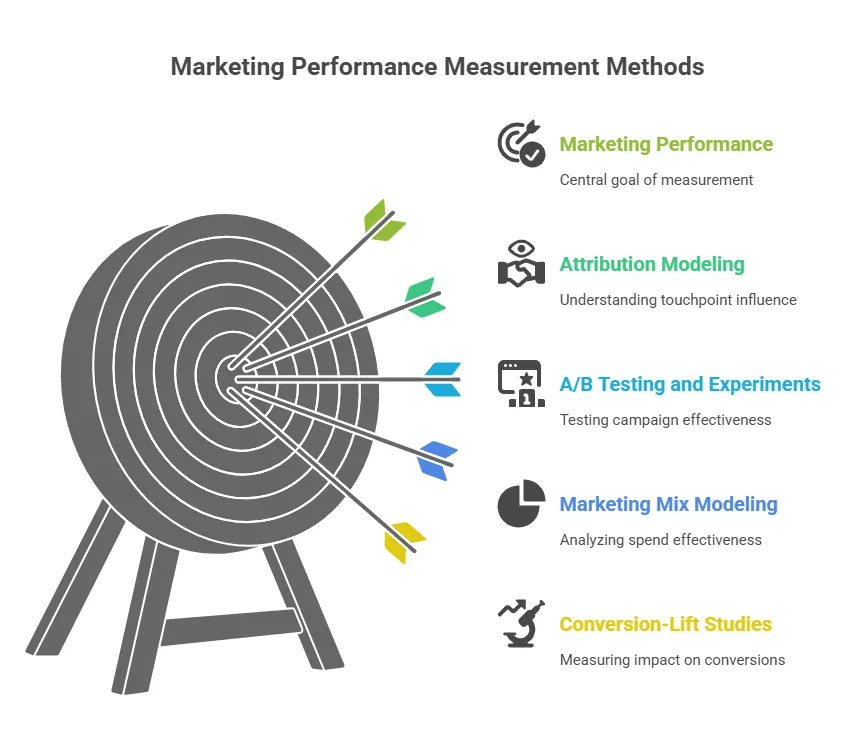
1. Attribution Modeling
Attribution modeling helps show which parts of your marketing actually influence conversions. It answers questions like: did someone convert after clicking on a Google Ads campaign, viewing a blog post, or engaging with a Facebook ad?
You have a few model options. First-touch credits the first interaction, last-touch credits the final step, and multi-touch attribution assigns credit across several touchpoints in the customer journey. Around 75% of marketers use multi-touch attribution. This shows how common it is for teams to want clearer insight into campaign performance.
Each model tells a slightly different story. Choosing the right one depends on your marketing strategy, campaign complexity, and available data. Attribution modeling gives marketers a solid starting point for evaluating campaign performance across channels.
2. A/B Testing and Experiments
Sometimes the smallest tweak, like a headline or CTA button, can drive major results. A/B testing lets you compare two versions of a campaign, email, or landing page to see which one resonates more.
Split testing directs roughly equal traffic to version A and version B, then measures performance differences. It requires testing large enough samples to reach statistical significance, so you’re acting on data.
Around 77 % of companies run A/B tests on their websites. This shows how essential split testing has become in conversion rate optimization.
This method turns you into measurement specialists. It helps uncover what works and what needs changing across messaging, design, offers, and more. When done right with proper data and iterative testing, A/B experiments are a powerful tool in your marketing analytics toolbox.
3. Marketing Mix Modeling
Marketing mix modeling (MMM) is all about seeing the bigger picture. It uses historical data to analyze how different marketing channels, both online and offline, impact overall performance. It is a high-level, statistical analysis that helps you understand what’s really driving sales.
Unlike attribution models that focus on digital clicks and views, MMM looks at broader trends. It can measure the combined impact of things like Google Ads, TV spots, direct mail, influencer content, and even seasonality, all in one model.
Major platforms are leaning into it too. Meta, for example, has increased its focus on MMM, with adoption rising by over 80%.
For teams investing across multiple channels, MMM helps answer tough questions like: is this spend actually moving the needle? And where should we reallocate the budget next?
4. Conversion-Lift Studies
Conversion-lift studies are built for one thing: proving actual impact. Instead of just tracking clicks or impressions, they compare two groups: one that sees your campaign, and one that doesn’t. This control vs. exposed setup shows whether your marketing actually caused more conversions, or if those results would’ve happened anyway.
These experiments are especially useful for testing channels like Facebook Ads, where attribution can be fuzzy. You’ll find tools like GeoLift, and Measured that make it easier to run these tests without building everything from scratch.
Lift studies work best when you’re spending at scale and want to isolate the true effect of a campaign, like a product launch, brand awareness push, or cross-platform promotion. They’re slower than A/B tests, but they dig deeper into what’s really moving the needle.
5. Funnel Analysis
Funnel analysis helps you see how people move through your marketing and sales process, from first touch to final conversion. It maps each stage of the customer journey, so you can spot where users engage, where they hesitate, and where they drop off entirely.
This kind of analysis is key when you're running multi-step campaigns or complex landing pages. You might find that people are clicking your ads, visiting your site, but never completing the form. Or maybe they start a checkout, then bounce before payment.
By breaking the funnel into stages, your teams can pinpoint exactly where friction lives and fix it. Whether it’s slow load times, weak CTAs, or confusing UX, funnel data shows where to focus so you can unlock more conversions with fewer wasted clicks.
P.S. Still feeling stuck turning all these methods into real results? Don’t worry, you can team up with expert agencies that know how to measure smarter and scale faster. Check out this list of the Best Performance Marketing Agencies to get started.
How to Choose the Right Measurement Method
Not every method fits every team. The tools you use to track performance should match your marketing budget, your channel mix, and how advanced your data setup is.
Here’s a simple way to think about it based on budget levels:
- Under $3M/year: Start with digital tracking and in-platform attribution reports from tools like Google Analytics 4, Facebook Ads Manager, or your CRM. These are fast, accessible, and help you keep a pulse on campaign performance.
- $3M–$5M/year: Start layering in structured tests like A/B experiments or lift studies. At this stage, you’ve got more channels running and enough volume to measure incrementality with real control groups.
- Over $5M/year: Add marketing mix modeling to the stack. It helps with budget forecasting, cross-channel planning, and long-term ROI tracking, especially when you’re managing both online and offline spend.
The bigger the budget, the more critical it becomes to move beyond surface metrics and build a full measurement strategy that combines tactical KPIs with high-level effectiveness analysis.
Top 5 Marketing Measurement Tools To Know
Once you know what to measure and which methods fit your strategy, the next step is choosing the right tools. The best platforms help you collect, visualize, and act on performance data, drowning in dashboards.
1. Google Analytics 4
Google Analytics 4 helps marketers track how users interact with their website across devices and sessions. It offers detailed behavior analysis, shows where traffic is coming from, and how visitors move through key conversion paths.
GA4 also includes event-based tracking, which lets you monitor actions like scrolls, video views, form submissions, or clicks, all without needing extra code. With built-in support for attribution models and integration with Google Ads and Search Console, GA4 is a go-to tool for teams looking to understand and improve digital marketing performance.
2. HubSpot
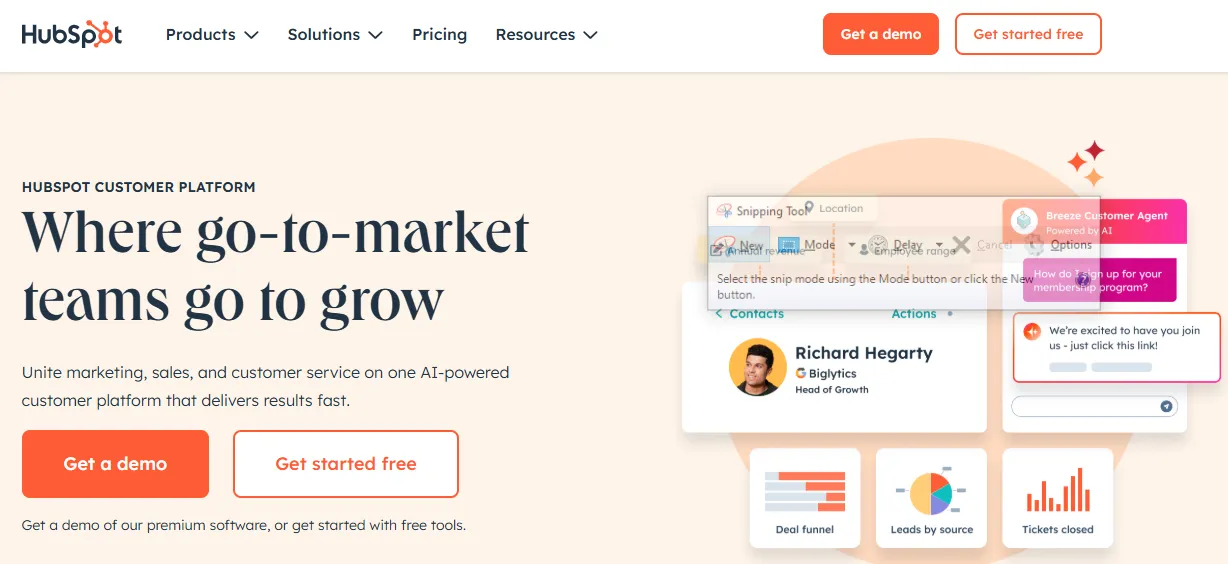
HubSpot brings your CRM, marketing analytics, and campaign tracking into one platform. It gives teams a clear view of how contacts move through the funnel, from first visit to form conversion to closed deal. You can track email performance, landing page engagement, lead source, and attribution without jumping between tools.
The built-in dashboards make it easy to monitor KPIs like cost per lead, click-through rates, and customer acquisition costs. If you want marketing and sales data in one place, HubSpot keeps everything connected and decision-ready.
3. Tableau
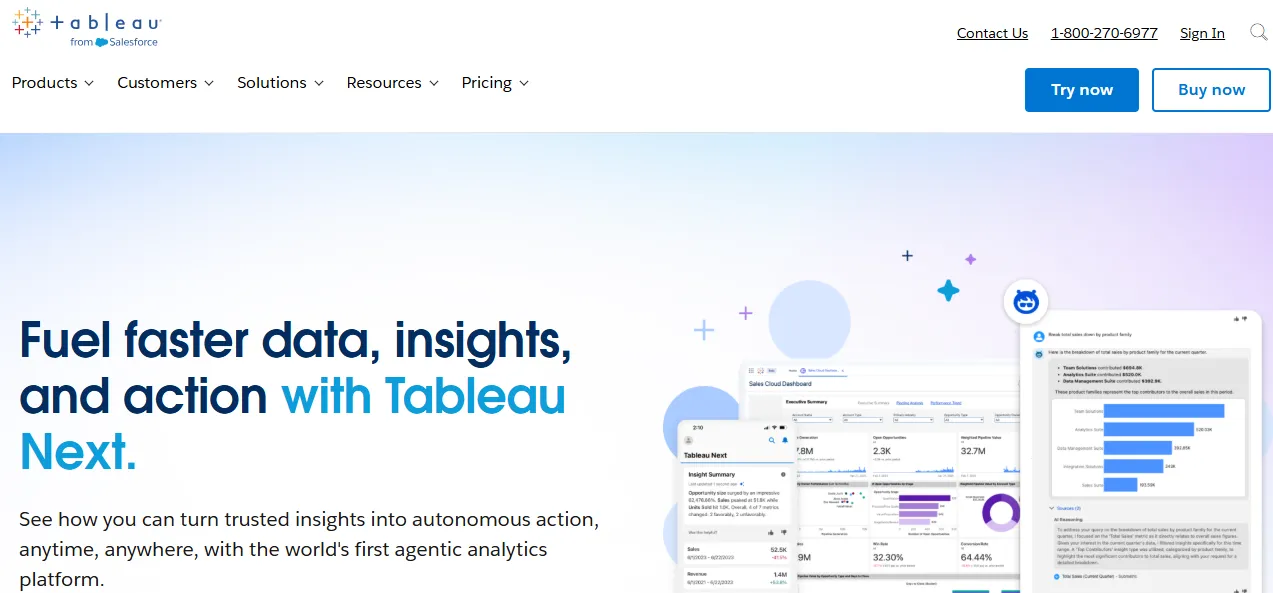
Tableau turns raw performance data into clean, visual dashboards your team can actually use. It connects with tools like Google Analytics, CRMs, ad platforms, and spreadsheets to bring everything into one place. You can track campaign performance, website traffic, lead quality, and more, all from a single view.
Dashboards are customizable, so senior marketers can focus on business outcomes while individual teams dive into tactical metrics. Tableau is especially useful for sharing insights across cross-functional teams without overwhelming them with complex data exports.
4. Mixpanel

Mixpanel is built for teams that care about what users actually do instead of just knowing where they came from. It tracks product interactions, feature usage, and user flows across web and mobile apps. You can analyze how different segments behave, where they drop off in the funnel, and which actions lead to conversion.
It’s especially helpful for product-led growth teams that need to link in-app behavior to marketing performance. With flexible dashboards and event tracking, Mixpanel makes behavioral data easy to explore and act on.
5. Ruler Analytics
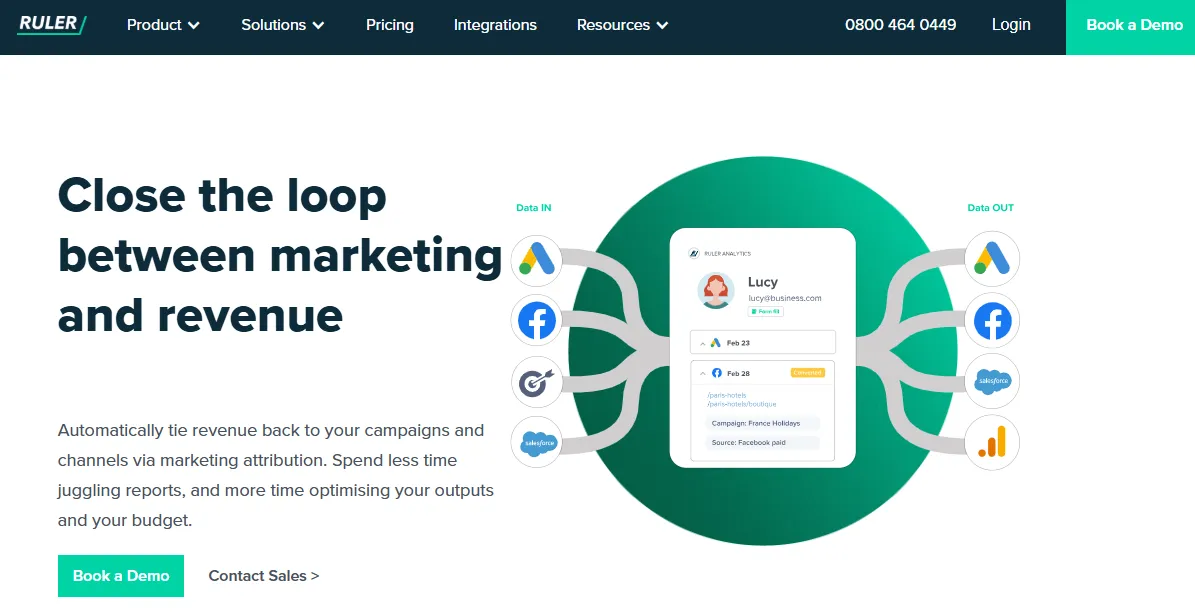
Ruler Analytics helps you connect anonymous website activity to real revenue. It tracks every touchpoint across the customer journey, clicks, calls, and form submissions, and ties them back to your CRM once a lead converts. You get a full view of how different channels contribute to the pipeline with multi-touch attribution that’s built for B2B teams.
It also shows which campaigns drive the highest-quality leads, not just the most clicks. If you’re serious about attribution and revenue reporting, Ruler gives you data that actually closes the loop.
Common Challenges in Marketing Measurement
Even with great tools and solid KPIs, marketing measurement isn’t always straightforward. Teams run into roadblocks, some technical, some strategic, that make it harder to track what’s really happening.
Some common challenges that come up again and again are:
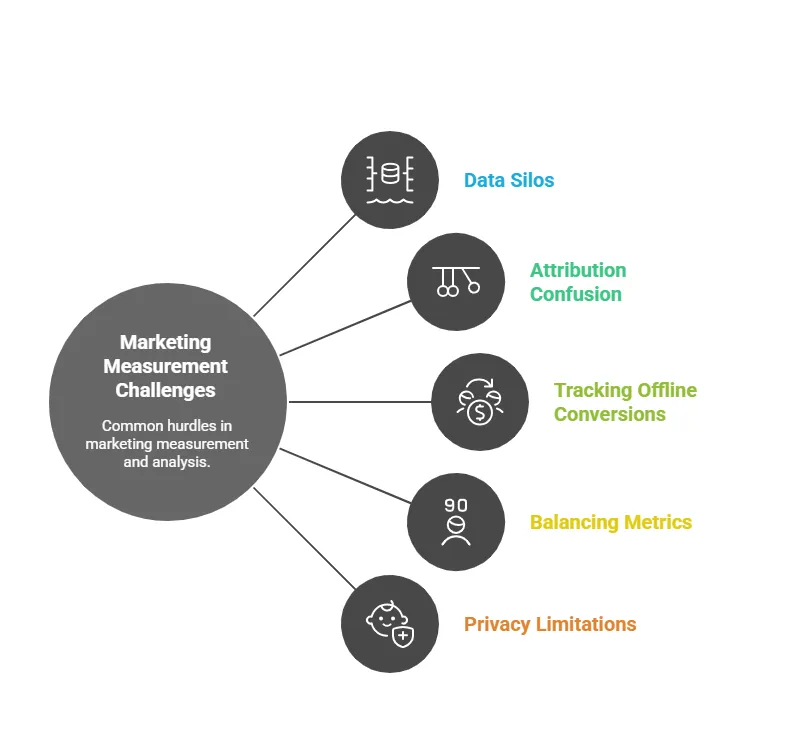
- Data silos between platforms: When analytics, CRM, and ad data all live in separate systems, it’s hard to get a unified view of performance. Teams waste time stitching reports together instead of making decisions.
- Attribution confusion: Different models tell different stories, and it’s not always clear which touchpoints deserve credit. This creates tension between teams and makes ROI harder to prove.
- Tracking offline conversions: Phone calls, in-person visits, or offline sales often go untracked. This leaves gaps in your customer journey data.
- Balancing quantity vs. quality of metrics: It’s easy to measure everything, but not everything matters. Without a focused measurement strategy, teams end up buried in dashboards instead of insights.
- Privacy and cookie/data limitations: With third-party cookies disappearing and privacy regulations tightening, it’s getting harder to rely on traditional tracking. This makes first-party data and clean attribution models more important than ever.
Unlock the Power of Precise Marketing Metrics With inBeat Agency
Marketing measurement gives you the clarity to make confident decisions. It connects performance data to real outcomes and helps teams focus on what actually drives growth. With the right KPIs, methods, and tools, you can cut through the noise, sharpen your strategy, and scale what works.
Key takeaways
- Strategic KPIs measure long-term outcomes while tactical KPIs track short-term performance
- Your KPI stack should reflect your business model and growth stage
- A/B testing helps optimize campaigns through real user behavior
- Attribution models reveal which channels influence conversions across the journey
- Marketing mix modeling tracks both online and offline impact
- Conversion-lift studies isolate true campaign impact through experimentation
- Funnel analysis shows where users drop off and why
- Measurement tools should match your team’s budget, data maturity, and reporting needs
If you want to run campaigns that are built on real insights, inBeat Agency experts can help you scale with data-backed creative and performance-first strategy.
Book a free strategy call now to align your growth goals with campaigns that actually convert.
FAQs
What are the most important KPIs in digital marketing?
This depends on your goals, but some widely tracked KPIs include click-through rate (CTR), cost per lead (CPL), conversion rate, customer acquisition cost (CAC), and return on ad spend (ROAS). These help teams measure campaign performance, funnel health, and revenue impact.
What’s the best way to measure multi-channel campaigns?
Use a mix of multi-touch attribution, conversion-lift studies, and unified dashboards. Attribution shows how different channels contribute across the customer journey. Lift studies help prove actual impact. Bringing it all together in a centralized reporting setup gives you a clear, end-to-end view.
What are the four levels of marketing measurement in order?
Marketing measurement can be broken into four key levels—each one building on the last:
- Activity metrics: Track things like ad impressions, email sends, or content output
- Engagement metrics: Cover clicks, opens, shares, and social media interactions
- Performance metrics: Look at conversions, form fills, CPL, CAC, and ROI
- Business impact metrics: Connect marketing to revenue, CLTV, and strategic goals
What are the four methods of marketing?
The four main methods include:
- Advertising: Paid media like Google Ads, display, social media ads
- Direct marketing: Email campaigns, SMS, or direct mail
- Personal selling: sales reps, demos, and consultative outreach
- Public relations: Earned media, press coverage, brand storytelling
What are the 4 Ps of marketing?
The 4 Ps stand for:
- Product: What you're selling
- Price: How much does it cost
- Place: Where and how it's sold
- Promotion: How you market it (ads, social media, email, etc.)
What are the four stages of measurement?
The four stages of measurement are simple but powerful:
- Define goals: Set clear objectives tied to business outcomes
- Choose KPIs: Align metrics with each stage of the marketing funnel
- Collect and analyze data: Use tools like GA4, attribution platforms, CRM
- Act on insights: Adjust your marketing strategy based on what’s working

